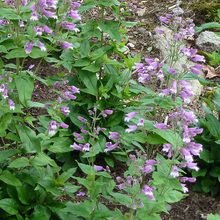Penstemon smallii is a native beardtongue valued for its lavender pink tubular flowers and glossy semi evergreen foliage. It blooms prolifically while remaining compact and resilient, performs well in both formal and naturalistic settings.
Height & Spread: 12 - 18 in x 12 - 18 in
Bloom Time: Late spring to early summer
Light Requirements: Full sun to light shade
Soil Preference: Well drained, rocky or sandy soils
Watering Needs: Low once established
Deer Resistance: Deer resistant
Native Status
Native to the southern Appalachian region and southeastern U.S., especially in rocky woodlands and open slopes.
WILDLIFE & INSECTS
Bees
- Attracts long tongued bees and small carpenter bees which forage deep into the tubular blooms for pollen and nectar.
Butterflies
- Visited by swallowtails and small hairstreaks in sunny open sites during bloom season.
Spacing & Landscape Use
Spacing Recommendations
- Space 12 - 18 in apart to maintain airflow and define clump shape.
Landscape Placement
- Ideal for sunny slopes, rock gardens, native borders, and dry meadows. Its compact form fits easily into small gardens or matrix plantings.
Companion Plants
- Echinacea purpurea (Purple Coneflower) - Shares pollinator value and dry soil preferences, flowering just after Penstemon.
- Asclepias tuberosa (Butterfly Weed) - Adds bold orange blooms and supports Monarchs in well drained, sunny sites.
- Phlox subulata (Creeping Phlox) - Forms a spring blooming carpet that pairs well with upright Penstemon stems.
- Coreopsis verticillata 'Zagreb' - Offers bright yellow summer color and fine foliage in sunny garden beds.
- Salvia azurea (Blue Sage) - Produces sky blue flower spikes that contrast with Penstemon’s rosy tones in dry soils.



